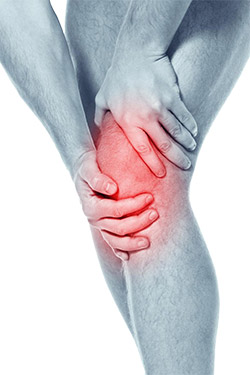Learn More By Calling
760.940.3000 Today!
The Plague of Aging & Osteoarthritis
 It is the most common form of arthritis and the most common joint disease around.
It is the most common form of arthritis and the most common joint disease around.
It’s osteoarthritis, and its menacing effects on the knees alone plague the daily lives of more than 10 million people.
It sets its sights on the most experienced among us – those older than 45 – as well as the better looking (more women than men are typically affected by osteoarthritis), and it targets its pain at the ends of our fingers, thumbs, necks, lower backs, knees, and hips.
It can either wear away at the moving parts of our joints, such as the shock-absorbing cartilage called the meniscus, and expose our bones to greater wear and tear, or it can add on nasty bumps or spikes called bone spurs. One type, labeled nodal osteoarthritis, is the culprit in the bony enlargement of our joints, particularly in the hands.
Even More at Risk
In addition to age and gender, you inherit a major risk factor for osteoarthritis if you have joints that are not aligned properly. Some of the most recognized misalignments include bow legs, dislocated hips, or double-jointedness.
You can also literally inherit some risk of osteoarthritis through a hereditary gene defect that can cause deterioration of cartilage in your joints.
Risk also sometimes comes at the expense of your experiences, whether you chose them or not. A traumatic joint injury, like the tearing of a ligament or meniscus, can accelerate the onset of osteoarthritis. Or it can be welcomed in through joints that have been overused due to physical labor or sports.
But don’t think that an idle lifestyle is any better for your chances of developing osteoarthritis, because obesity is the next big risk on the list. Being overweight during the middle of life or in later years is among the strongest risk factors for osteoarthritis of the knee.
How Can I Tell If It’s Coming?
The most apparent signs that osteoarthritis might be on its way include steady or intermittent pain in a joint. Another symptom could be stiffness that tends to follow periods of inactivity, such as sleeping through the night or sitting for a period of time. You might also notice swelling or tenderness in one or more of your joints, though that may not necessarily occur on both sides of your body at the same time. And maybe the worst of all red flags is that awful crunching feeling or sound of bone rubbing on bone while you move the problem joint. That one is officially called crepitus.
But at those points in time, osteoarthritis has been a long time in coming. The gradual condition first begins to develop when your body’s natural bone repair mechanisms of tissue absorption and synthesis get out of balance, allowing bone spurs and bone cysts to grow where they previously didn’t have opportunity to grow. Before they become painfully noticeable, those bone spurs or bone cysts can sometimes be discovered by your doctor through radiographic diagnosis. Common problem areas spotted on an x-ray include an asymmetrical narrowing of joint spaces, a narrowing of the area surrounding a joint (periarticular sclerosis), bone spurs (osteophytes), and a fluid-filled sac of thickened joint lubricant that extrudes from the bone (subchondral bone cysts).
How Do I Treat It?
Once diagnosed, there aren’t too many options available to you. That’s because osteoarthritis is a condition that progresses slowly over a period of many years and cannot be cured. The treatments we focus on primarily deal with decreasing the unwelcome symptoms of the condition.
The most successful forms of osteoarthritis treatment are the ones that help limit your joint pain, increase the range of motion in your arms and legs, and increase your muscle strength so you can keep doing the things you love to do and prevent falls or other costly injuries.
Depending on your particular circumstances, such treatments can take the shape of non-operative procedures as simple as pain medications, physical therapy, and walking aids, or as complex as shock absorption and re-alignment of joints through special shoes or foot gear (orthotics) that serve to limit strain from bodily weight and movement on the most sensitive joint areas.
Works Cited
Harms, Roger W., M.D. “Osteoarthritis Risk Factors.” Mayo Clinic. Mayo Foundation for Medical Education and Research, n.d. Web.
“Who Gets Osteoarthritis?” Arthritis Foundation. Arthritis Foundation, n.d. Web.

